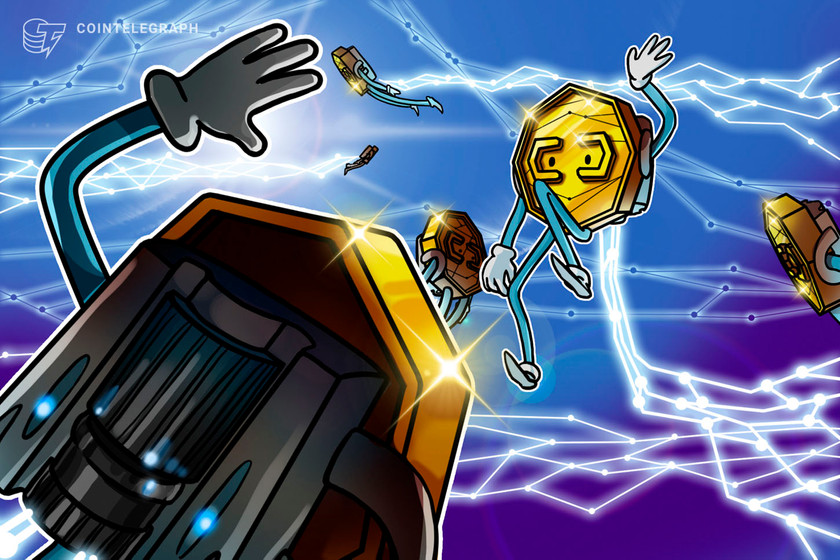Polygon (MATIC) jumps ahead as the race for Layer-2 adoption picks up

Increasing volume and TVL on QuickSwap, along with steady growth in the number of projects joining Polygon have analysts suggesting that MATIC price is undervalued.
Recently layer 1 solutions like the Solana (SOL) and Cosmos (ATOM) have grown in prominence thanks to each network’s faster transaction times and lower fees when compared to the Ethereum network. An even greater focus has fallen on layer 2 solutions that can help Ethereum keep up with the competition as it continues its process of switching to proof-of-stake.
One project that has seen a steady rise in user activity and transactions over the past 2 months is Polygon (MATIC), a platform for Ethereum scaling and infrastructure development.

Data from Cointelegraph Markets and TradingView shows that since hitting a low of $0.26 as the market sold off on April 18, MATIC price has climbed 50% to $0.39 as adoption of this expanding L2 platform begins to ramp up.
Popular projects migrate to Polygon
Following the early February announcement that the Matic Network would be rebrand to Polygon as part of its effort to become the go-to L2 aggregator for the Ethereum network, the protocol has seen a significant increase in user and project adoption.
Polygon, the top #ethereum layer 2 is going nuts!
Integrations with Aave, Pooltogether, Sushiswap, Open Sea, Curve Finance, Decentraland, and loads of other big #defi applications.
TVL on Aave on Polygon nearing 1 billion. $matic undervalued
— Lark Davis (@TheCryptoLark) April 25, 2021
Since the rebrand, multiple decentralized finance (DeFi) and nonfungible token-related projects have made the decision to integrate with Polygon to take advantage of its fast, low fee environment.
Some of the more significant DeFi integrations include the decentralized exchange SushiSwap (SUSHI) and Curve Finance (CRV), while OpenSea, Decentraland (MANA) and Aavegotchi (GHST) are large NFT communities that now utilize the Polygon network.
On March 31, the popular DeFi lending platform AAVE announced that it was exploring “new scalability frontiers” with Polygon, and the subsequent launch of AAVE on the L2 solution rapidly grew to $1 billion worth of liquidy and more than 7,200 users just 10 days after launch.
A big day for @0xPolygon and the whole Ethereum ecosystem!
$1 BILLION in liquidity and 7.2k USERS on a single application, 10 DAYS after the launch!
Huge thanks to the amazing @AaveAave team and the whole Ethereum community!
This is just the beginning, stay tuned! pic.twitter.com/wqvoOLgNbT
— Mihailo Bjelic (@MihailoBjelic) April 24, 2021
DEX volume increases
Popular decentralized exchanges like Uniswap and SushiSwap were a major catalyzing force for the growth of DeFi and the cryptocurrency sector as a whole over the past year, demonstrating the importance of a properly functioning DEX for the growth of the ecosystem.
While SushiSwap is one protocol that has made integrations with the Polygon network along with numerous other blockchains, the QuickSwap DEX is a project that is solely focused on increasing available liquidity for the Polygon ecosystem.

As seen in the charts above, liquidity and trading volume on QuickSwap saw rapid gains beginning in late February and this trend continued throughout March. Over the past two weeks, there has been a noticeable uptick in volume on the platform and this corresponds with the recent Polygon adoptions.
Increased activity on decentralized exchanges is partially due to the growing list of projects now available on Polygon. A quick scroll through the project’s Twitter feed shows a long list of recent integrations including IoTeX (IOTX), Everipedia (IQ), Gelato Network (GELATO), Just Bet (WINR) and Umbrella Network (UMB), to name a few.
Going forward, it’s likely that a growing number of Ethereum-based projects will look for a faster, low-fee environment that also allows them to stay on the top smart contract platform. If they shift to Polygon, there is a chance of significant upside potential and the current growth in MATIC price and the rising TVL of QuickSwap both serve as proof that the protocol is a strong layer-2 contender.
The views and opinions expressed here are solely those of the author and do not necessarily reflect the views of Cointelegraph.com. Every investment and trading move involves risk, you should conduct your own research when making a decision.



